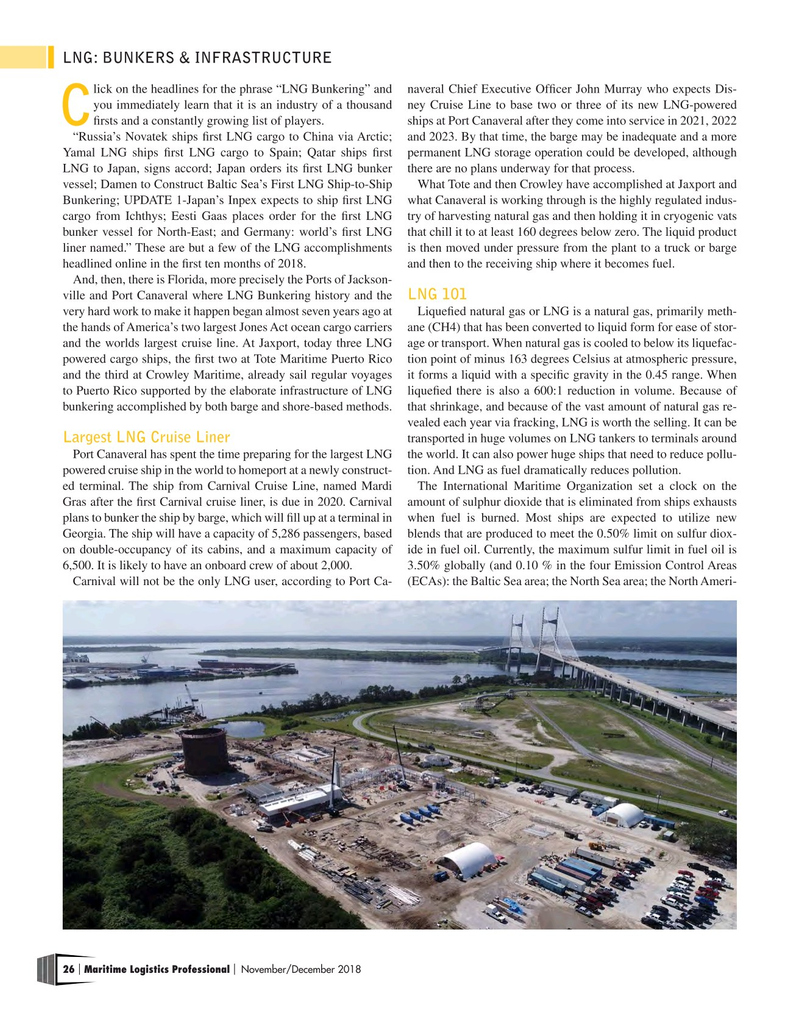
Page 26: of Maritime Logistics Professional Magazine (Nov/Dec 2018)
Regulatory & Environmental Review
Read this page in Pdf, Flash or Html5 edition of Nov/Dec 2018 Maritime Logistics Professional Magazine
LNG: BUNKERS & INFRASTRUCTURE lick on the headlines for the phrase “LNG Bunkering” and naveral Chief Executive Offcer John Murray who expects Dis- you immediately learn that it is an industry of a thousand ney Cruise Line to base two or three of its new LNG-powered
Cfrsts and a constantly growing list of players. ships at Port Canaveral after they come into service in 2021, 2022 “Russia’s Novatek ships frst LNG cargo to China via Arctic; and 2023. By that time, the barge may be inadequate and a more
Yamal LNG ships frst LNG cargo to Spain; Qatar ships frst permanent LNG storage operation could be developed, although
LNG to Japan, signs accord; Japan orders its frst LNG bunker there are no plans underway for that process.
vessel; Damen to Construct Baltic Sea’s First LNG Ship-to-Ship What Tote and then Crowley have accomplished at Jaxport and
Bunkering; UPDATE 1-Japan’s Inpex expects to ship frst LNG what Canaveral is working through is the highly regulated indus- cargo from Ichthys; Eesti Gaas places order for the frst LNG try of harvesting natural gas and then holding it in cryogenic vats bunker vessel for North-East; and Germany: world’s frst LNG that chill it to at least 160 degrees below zero. The liquid product liner named.” These are but a few of the LNG accomplishments is then moved under pressure from the plant to a truck or barge headlined online in the frst ten months of 2018. and then to the receiving ship where it becomes fuel.
And, then, there is Florida, more precisely the Ports of Jackson- ville and Port Canaveral where LNG Bunkering history and the
LNG 101 very hard work to make it happen began almost seven years ago at Liquefed natural gas or LNG is a natural gas, primarily meth- the hands of America’s two largest Jones Act ocean cargo carriers ane (CH4) that has been converted to liquid form for ease of stor- and the worlds largest cruise line. At Jaxport, today three LNG age or transport. When natural gas is cooled to below its liquefac- powered cargo ships, the frst two at Tote Maritime Puerto Rico tion point of minus 163 degrees Celsius at atmospheric pressure, and the third at Crowley Maritime, already sail regular voyages it forms a liquid with a specifc gravity in the 0.45 range. When to Puerto Rico supported by the elaborate infrastructure of LNG liquefed there is also a 600:1 reduction in volume. Because of bunkering accomplished by both barge and shore-based methods. that shrinkage, and because of the vast amount of natural gas re- vealed each year via fracking, LNG is worth the selling. It can be transported in huge volumes on LNG tankers to terminals around
Largest LNG Cruise Liner
Port Canaveral has spent the time preparing for the largest LNG the world. It can also power huge ships that need to reduce pollu- powered cruise ship in the world to homeport at a newly construct- tion. And LNG as fuel dramatically reduces pollution.
ed terminal. The ship from Carnival Cruise Line, named Mardi The International Maritime Organization set a clock on the
Gras after the frst Carnival cruise liner, is due in 2020. Carnival amount of sulphur dioxide that is eliminated from ships exhausts plans to bunker the ship by barge, which will fll up at a terminal in when fuel is burned. Most ships are expected to utilize new
Georgia. The ship will have a capacity of 5,286 passengers, based blends that are produced to meet the 0.50% limit on sulfur diox- on double-occupancy of its cabins, and a maximum capacity of ide in fuel oil. Currently, the maximum sulfur limit in fuel oil is 6,500. It is likely to have an onboard crew of about 2,000. 3.50% globally (and 0.10 % in the four Emission Control Areas
Carnival will not be the only LNG user, according to Port Ca- (ECAs): the Baltic Sea area; the North Sea area; the North Ameri- 26 Maritime Logistics Professional November/December 2018 | |

 25
25

 27
27
